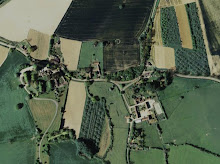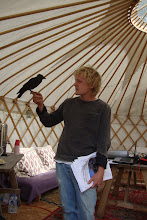
One component of the National Trust orchard training day I attended on Thursday at Day's Cottage was a talk by mistletoe enthusiast and expert Jonathan Briggs.

Mistletoe being harvested near Dieppe, France around 1930 to be exported to England for Christmas. (courtesy of J. Briggs)
Viscum album, the European species (that exists as several subspecies across Europe and Asia) is just one of ~1300 species of mistletoe worldwide. In the 1990s a national survey of the plant's distribution showed gardens to be the most common habitat, closely followed by orchards, or parks (in eastern counties). It thus favours the open habitats of wood-pasture, especially where preferred host species can also be found. In order of preference, these hosts are 1) apple, 2) lime 3) hawthorn, 4) poplar, 5) maple and 6) willow, but it has been recorded on many others as well.

Nationally, mistletoe is distributed across much of Britain, but sparsely, yet it becomes abundant in the counties of Worcestershire (e.g. Conderton in above photo), parts of Gloucestershire, Herefordshire and Somerset. This correlates with those areas with the most orchards BUT this is not a causal relationship. If you took away all the orchards in these counties it would still be relatively abundant compared with other regions. Mistletoe can survive across much of the UK, but it won't spread naturally except in these areas. Quite why is still a mystery!

Image courtesy of Mistletoe Matters Consultancy
As well as being important for Druid ceremonies, mistletoe is a valuable component of orchard biodiversity. Firstly, as it is winter flowering it provides a valuable nectar source for insects like flies in February.
The berries are food for birds, especially mistle thrushes (hence the name) and blackcaps. Indeed blackcaps are the primary vector for spreading the seed since they only eat the outer casing and wipe the sticky seed off on a convenient branch. (The best way of seeding your own tree with mistletoe is to mimic this technique on branches of a suitable species. Choose younger branches, 1 - 2 inches in diameter and use berries harvested in February and March for the best germination results. The seeds will take 4 years to produce the first two leaves, but after that will grow exponentially so you need to be careful for things not to get out of hand! )
Mistletoe also has a group of insects that are specifically associated with it. It is a hemi-parasite and will sap strength from the host tree if not controlled but in general it is certainly a beneficial component of any traditional orchard.







005.jpg)
006.jpg)




.JPG)
.JPG)





.JPG)
.JPG)




